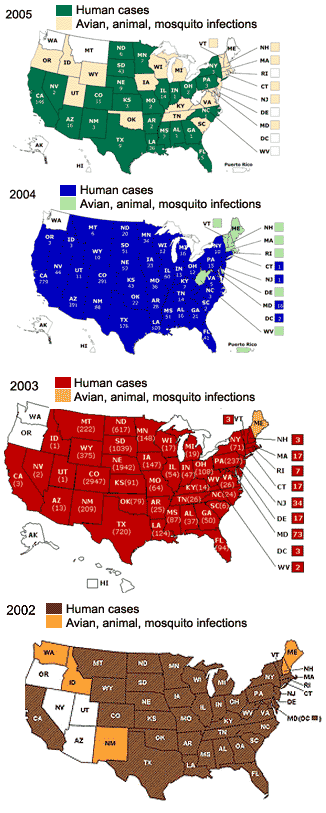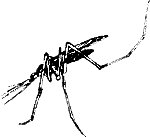 | West Nile Virus Spreads |
 | West Nile Virus Spreads |
By Ellen Kuwana  Neuroscience for Kids Staff Writer Neuroscience for Kids Staff Writer August 19, 2002 Updated August 20, 2005 West Nile virus (WNV) is on the move. Since it was first detected in New York City in 1999, WNV has spread across the United States. In 1999, 62 people became ill and 7 people died from infection. In 2001, there were 66 cases and 9 deaths from WNV; in 2002, there were 4,156 cases and 284 deaths; in 2003, there were 9,862 cases and 264 deaths. There was a decline in human cases and deaths in 2004: 2,539 people became ill and there were 100 deaths caused by WNV (statistics from the CDC). Symptoms Symptoms of WNV usually appear 3 to 6 days after a bite from an
infected mosquito, although it can take as long as two weeks to develop
symptoms. Many people who get bit by mosquitoes infected with WNV,
however, do not show any symptoms and most people who do get sick
experience only mild symptoms, such as fever, chills, sore throat, nausea,
vomiting, headache or muscle aches. Sometimes a rash develops around the
head, trunk, arms or legs. Of those who fall ill, only about 1 in 150
develops the more severe symptoms of encephalitis (brain swelling) or
meningitis (infection of the meninges): stiff
neck, muscle weakness, and confusion. Symptoms of WNV usually appear 3 to 6 days after a bite from an
infected mosquito, although it can take as long as two weeks to develop
symptoms. Many people who get bit by mosquitoes infected with WNV,
however, do not show any symptoms and most people who do get sick
experience only mild symptoms, such as fever, chills, sore throat, nausea,
vomiting, headache or muscle aches. Sometimes a rash develops around the
head, trunk, arms or legs. Of those who fall ill, only about 1 in 150
develops the more severe symptoms of encephalitis (brain swelling) or
meningitis (infection of the meninges): stiff
neck, muscle weakness, and confusion.WNV infections can leave lasting effects. More than 50% of patients who had encephalitis in 2000 still complain of fatigue and memory problems. Many of these people still suffer from muscle weakness and more than a third suffer from depression.
How is the virus transmitted? WNV is spread by
mosquitoes that feed on infected birds. As infected birds migrate to other
areas, they transmit WNV to mosquitoes in new geographic regions, thereby
spreading the virus to other localities. These mosquitoes then bite
humans, who become infected. The chance of catching WNV, however, is low.
Only about 1% of mosquitoes carry the virus and only 1% of humans who
are bitten will go on to develop severe symptoms. The elderly and those
with compromised immune systems are most at risk. WNV is spread by
mosquitoes that feed on infected birds. As infected birds migrate to other
areas, they transmit WNV to mosquitoes in new geographic regions, thereby
spreading the virus to other localities. These mosquitoes then bite
humans, who become infected. The chance of catching WNV, however, is low.
Only about 1% of mosquitoes carry the virus and only 1% of humans who
are bitten will go on to develop severe symptoms. The elderly and those
with compromised immune systems are most at risk.
The changing face of West Nile virus"Know thy enemy," a Chinese proverb advises. West Nile is a virus with an ever changing face. Just when scientists think they've established a pattern for the virus, something changes.It's infecting more animals: In 1999, scientists thought that WNV infected only birds and humans. In 2002, it has been found in other animals, such as horses. In just three years, WNV has infected 31 kinds of mosquitoes and has been found in 115 species of birds in the United States alone. It's affecting younger people: In 1999, the average age of infected patients was 65 years old. In 2002, it was 55 years old. It's infecting people earlier in the summer: In 1999, the first cases were reported around mid-July, with most cases occurring in mid-August; this year by mid-August there have been several hundred reported cases. The first cases in 2002 were reported in mid-June. Is the virus becoming more virulent? Or is it a new strain? Which species of mosquitoes are carrying the virus? At this time, no one knows. The Centers for Disease Control has 20 scientists working on these questions in Louisiana, Mississippi and Arkansas.
History of West Nile virus in the US West Nile virus was first detected in the
United States in New York City in 1999 when birds began to die,
including some at the zoo. These birds were tested and WNV was discovered.
That outbreak caused 62 people to fall ill, seven of whom died. These
statistics highlight the importance of birds in detecting West Nile virus.
Since the birds fall ill first, being vigilant about reporting dead birds
to health authorities can assist in locating, tracking, and controlling
the spread of WNV. West Nile virus was first detected in the
United States in New York City in 1999 when birds began to die,
including some at the zoo. These birds were tested and WNV was discovered.
That outbreak caused 62 people to fall ill, seven of whom died. These
statistics highlight the importance of birds in detecting West Nile virus.
Since the birds fall ill first, being vigilant about reporting dead birds
to health authorities can assist in locating, tracking, and controlling
the spread of WNV.In November of 2001, researchers announced that they had successfully vaccinated mice against the virus. This work, it is hoped, will lead to better tests for detection and control of WNV in humans, and possibly lead to a human vaccine. Don't Panic -- Protect and Prevent!In the meantime, if you live in an area where WNV has been detected, wear long pant and shirts with long sleeves during and after sundown when mosquitoes come out to feed. Apply insect repellent containing DEET to exposed skin (check with your doctor for children under 2 years old). Also, get rid of any standing water on your property and avoid areas with stagnant water because this is where mosquitoes breed. |
| Did you know?
|
|
|
References:
|
| GO TO: | Neuroscience In The News | Explore the Nervous System | Table of Contents |
![[email]](./gif/menue.gif) Send E-mail |
 Fill out survey |
 Get Newsletter |
 Search Pages |